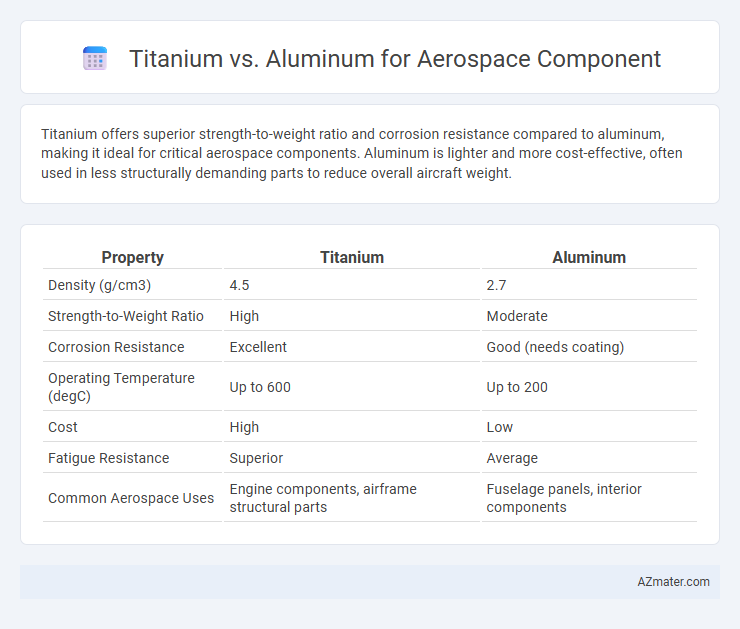Titanium offers superior strength-to-weight ratio and corrosion resistance compared to aluminum, making it ideal for critical aerospace components. Aluminum is lighter and more cost-effective, often used in less structurally demanding parts to reduce overall aircraft weight.
Table of Comparison
| Property | Titanium | Aluminum |
|---|---|---|
| Density (g/cm3) | 4.5 | 2.7 |
| Strength-to-Weight Ratio | High | Moderate |
| Corrosion Resistance | Excellent | Good (needs coating) |
| Operating Temperature (degC) | Up to 600 | Up to 200 |
| Cost | High | Low |
| Fatigue Resistance | Superior | Average |
| Common Aerospace Uses | Engine components, airframe structural parts | Fuselage panels, interior components |
Introduction to Titanium and Aluminum in Aerospace
Titanium and aluminum are critical materials in aerospace engineering due to their unique properties. Titanium offers exceptional strength-to-weight ratio, corrosion resistance, and high-temperature performance, making it ideal for structural components and engine parts. Aluminum is favored for its lightweight nature, excellent machinability, and cost-effectiveness, often used in airframes and skin panels.
Material Properties Overview
Titanium offers superior strength-to-weight ratio and exceptional corrosion resistance compared to aluminum, making it ideal for aerospace components subjected to high stress and extreme environments. Aluminum provides lighter weight and excellent machinability with good thermal conductivity, but lower fatigue resistance and strength limit its use in critical load-bearing structures. Advanced aerospace applications often use titanium alloys for critical parts due to their high tensile strength up to 1,400 MPa and density around 4.43 g/cm3, whereas aluminum alloys typically exhibit strengths near 500 MPa and density of approximately 2.7 g/cm3.
Strength-to-Weight Ratio Comparison
Titanium offers a superior strength-to-weight ratio compared to aluminum, making it highly desirable for aerospace components that require durability without significant weight addition. While aluminum is lighter, titanium's strength allows for thinner, lighter parts that withstand higher stress and temperatures, enhancing overall aircraft performance. This balance between lightweight and strength makes titanium the preferred material in critical aerospace structural applications, including airframes and engine components.
Corrosion Resistance in Aerospace Environments
Titanium offers superior corrosion resistance compared to aluminum in aerospace environments, particularly against saltwater and oxidative conditions common at high altitudes. Its oxide layer provides a durable, self-healing barrier that prevents degradation, making it ideal for critical components exposed to harsh atmospheres. Aluminum, while lightweight and cost-effective, tends to corrode faster and requires protective coatings or treatments to maintain longevity in aerospace applications.
Cost Analysis: Titanium vs Aluminum
Titanium offers superior strength-to-weight ratio and corrosion resistance but comes with significantly higher raw material and machining costs compared to aluminum. Aluminum is more cost-effective due to lower material price and easier manufacturing processes, making it suitable for large-scale aerospace components with moderate strength requirements. Cost analysis must weigh titanium's premium performance benefits against aluminum's affordability to determine the optimal material for specific aerospace applications.
Manufacturability and Machinability
Titanium offers superior machinability for aerospace components due to its high strength-to-weight ratio and corrosion resistance, though it requires specialized tooling and slower cutting speeds to prevent work hardening. Aluminum, while easier to machine with standard tools and faster processing times, provides less strength and durability but excels in manufacturability for large-scale, lightweight aerospace parts. Optimization of manufacturing processes for titanium often involves advanced cooling techniques and precision CNC machining, whereas aluminum's machinability supports cost-effective production with simpler setups.
Fatigue and Creep Resistance
Titanium alloys exhibit superior fatigue resistance compared to aluminum, making them ideal for aerospace components subjected to cyclic stress. Titanium's exceptional creep resistance at elevated temperatures outperforms aluminum, which tends to deform more quickly under prolonged heat exposure. The higher strength-to-weight ratio and corrosion resistance of titanium further enhance its suitability for critical aerospace applications.
Applications in Modern Aerospace Components
Titanium offers superior strength-to-weight ratio and corrosion resistance, making it ideal for critical aerospace components such as airframe structures, engine parts, and fasteners. Aluminum remains widely used for its lightweight properties and cost-effectiveness, commonly found in fuselage panels and interior components. Advanced aerospace designs often combine titanium and aluminum to optimize performance, durability, and fuel efficiency.
Environmental Impact and Sustainability
Titanium offers superior corrosion resistance and strength-to-weight ratio, significantly extending aerospace component lifespan and reducing material replacement frequency. Aluminum's lower density enables fuel efficiency gains but involves higher environmental costs during extraction and processing due to energy-intensive refining techniques. Recyclability of both metals supports sustainable aerospace manufacturing; however, titanium's longer lifecycle often yields a lower overall environmental impact despite its higher initial resource demand.
Selecting the Right Material for Aerospace Design
Titanium offers superior strength-to-weight ratio and corrosion resistance, making it ideal for high-stress aerospace components where durability is critical. Aluminum provides excellent machinability and cost-effectiveness with lighter weight, suitable for less demanding structural parts. Selecting the right material depends on balancing performance requirements, weight constraints, and budget considerations in aerospace design.

Infographic: Titanium vs Aluminum for Aerospace Component
 azmater.com
azmater.com